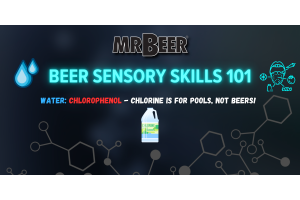6 Common Off Flavors in Your Homebrew and How to Fix Them or Prevent Them
If you are new to brewing or have been brewing for a long time you are bound to get some off flavors in your beer from time to time. This just happens, you can take all the precautions to prevent them from happening, but no one is immune. We wanted to discuss the 6 most poplar ones and what you can do to either prevent them from happening and how to fix them if it does happen if possible.
The first off flavor we will discuss is Acetaldehyde, which seems to be the most poplar off flavor that brewers get.
This is probably one of the most common off flavors you hear about with homebrewing. It’s usually described as green apple, twangy, cidery or like rotten apples in severe cases. Acetaldehyde is something that occurs naturally in the brewing process and is a chemical created by yeast. Usually it is converted to ethanol alcohol, but sometimes beers with very high gravity or beers that are under pitched, it can come out more and have a harder time going away. It can also be exacerbated if you are brewing at temps too high or in some cases, too low or if your yeast has a very slow start. A strong taste of rotten apples can mean a bacterial infection as well.
The second off flavor, which can also be very common is Diacetyl.
Ah yes this can be a tough one to relate to brewers who have never experienced it before but once you get it, you’ll know it. Usually it comes across as butter, buttered popcorn or butterscotch. Diacetyl is another compound that is naturally produced by yeast but is usually re absorbed into the yeast cells. This butter flavor can have a few causes. Weak or mutated yeast can be the cause, over or under oxygenating, extended low fermentation temps (like with lagers) and weak or short boils. The other cause of a butter flavor in your beer can be from old, outdated high alpha hops. We call this “hop creep”. Hop creep can happen with fresh hops too if you rush the Dry hopping process and don’t give your beer enough time to clean up after you make your hop additions. You can avoid this flavor by treating your yeast well, making sure it has all the nutrients it needs for high gravity wort and making sure you are not shocking the yeast when you pitch it with temperatures that are too far on one end of the extreme. Make sure you aerate well and don’t rush your fermentation process.
Another off flavor that brewers can get is kind of that Skunky flavor.
So, this is an interesting one. There are quite a few beers out there that people have come to love that have this flavor as almost a benchmark of the brand…. It is usually described as skunky or “catty” or sometimes like rubber. This comes from hops being exposed to UV light. We call this “light struck”. The alpha acids in hops break down and react with the hydrogen sulfide that the yeast produce. This creates mercaptan which is the same chemical that skunks spray when they are frightened. In commercial beers, you will usually find this flavor within clear or green bottles because they do not protect the beer from UV light. Avoid this flavor by protecting your fermenter and bottled beer from light.
One of the flavors that a lot of new brewers can get is from Oxidation, how can that be prevented?
Oxidization usually tastes stale or old or like wet cardboard or paper. Oxidation occurs mostly when an excessive amount of oxygen is introduced to the wort when it’s still very warm or after fermentation is complete during bottling or kegging. But also, not aerating your wort before pitching can cause it too. So, it’s a fine balance.
You can dodge this off flavor by avoiding excessive splashing or fermented beer and being careful when you do any kind of transfer. Also remember, warm liquid will always absorb oxygen far easier so lower the temp or your wort before being too rough with it.
A sour flavor, is also a type of off flavor, unless you are brewing a sour beer, what causes that and how can it be prevent or fixed?
So, this is often described as vinegar or acrid. Except for in sours this flavor is out of lace in other styles and is usually a sign of bacterial infection or wild yeast infection. When this happens, you will usually get a strong smell of vinegar as well. This is very disappointing when it happens and there’s nothing that can be done to save a beer that has been infected in that way. The easiest way to avoid this is to SANITIZE! This becomes even more important the more you have used your equipment many times. Also, it’s important to use clean water, and be aware that pathogens can often travel through the air so make sure to not open your fermenter lid unless you must.
The last one we will discuss is a sweet taste in your beer. Where does that come from and how is it prevented?
This one is self-explanatory in what it tastes like. If you are tasting your wort at the end of fermentation and it’s cloyingly sweet the cause of that is likely “under fermentation” This means the beer did not fully ferment all the available sugar into alcohol. Now the exception to this can be if you have added something like lactose sugar, this sweetness will never ferment out. If under fermentation is your issue, try waiting a few days and checking the temperature to make sure it is warm enough. Temperature issues are usually the cause of most stalled fermentations when it comes to Mr. Beer.





